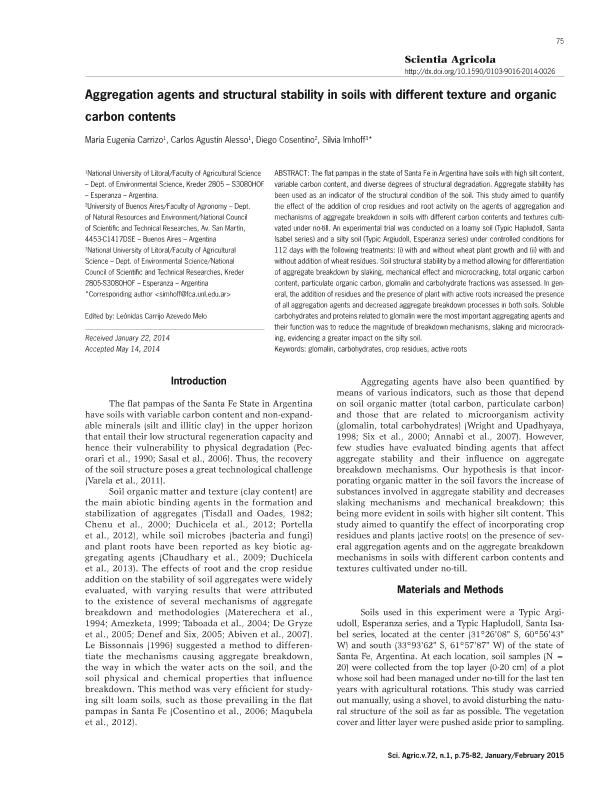Mostrar el registro sencillo del ítem
dc.contributor.author
Carrizo, Maria Eugenia

dc.contributor.author
Alesso, Carlos Agustín

dc.contributor.author
Cosentino, Diego

dc.contributor.author
Imhoff, Silvia del Carmen

dc.date.available
2017-05-19T18:14:34Z
dc.date.issued
2015-02
dc.identifier.citation
Carrizo, Maria Eugenia; Alesso, Carlos Agustín; Cosentino, Diego; Imhoff, Silvia del Carmen; Aggregation agents and structural stability in soils with different texture and organic carbon contents; Universidade de Sao Paulo. Escola Superior de Agricultura Luiz de Queiroz; Scientia Agricola; 72; 1; 2-2015; 75-82
dc.identifier.issn
0103-9016
dc.identifier.uri
http://hdl.handle.net/11336/16747
dc.description.abstract
The flat pampas in the state of Santa Fe in Argentina have soils with high silt content, variable carbon content, and diverse degrees of structural degradation. Aggregate stability has been used as an indicator of the structural condition of the soil. This study aimed to quantify the effect of the addition of crop residues and root activity on the agents of aggregation and mechanisms of aggregate breakdown in soils with different carbon contents and textures cultivated under no-till. An experimental trial was conducted on a loamy soil (Typic Hapludoll, Santa Isabel series) and a silty soil (Typic Argiudoll, Esperanza series) under controlled conditions for 112 days with the following treatments: (i) with and without wheat plant growth and (ii) with and without addition of wheat residues. Soil structural stability by a method allowing for differentiation of aggregate breakdown by slaking, mechanical effect and microcracking, total organic carbon content, particulate organic carbon, glomalin and carbohydrate fractions was assessed. In general, the addition of residues and the presence of plant with active roots increased the presence of all aggregation agents and decreased aggregate breakdown processes in both soils. Soluble carbohydrates and proteins related to glomalin were the most important aggregating agents and their function was to reduce the magnitude of breakdown mechanisms, slaking and microcracking, evidencing a greater impact on the silty soil.
dc.format
application/pdf
dc.language.iso
eng
dc.publisher
Universidade de Sao Paulo. Escola Superior de Agricultura Luiz de Queiroz
dc.rights
info:eu-repo/semantics/openAccess
dc.rights.uri
https://creativecommons.org/licenses/by-nc-sa/2.5/ar/
dc.subject
Glomalin
dc.subject
Carbohydrates
dc.subject
Crop Residues
dc.subject
Roots Activity
dc.subject.classification
Ciencias del Suelo

dc.subject.classification
Agricultura, Silvicultura y Pesca

dc.subject.classification
CIENCIAS AGRÍCOLAS

dc.title
Aggregation agents and structural stability in soils with different texture and organic carbon contents
dc.type
info:eu-repo/semantics/article
dc.type
info:ar-repo/semantics/artículo
dc.type
info:eu-repo/semantics/publishedVersion
dc.date.updated
2017-05-18T21:19:16Z
dc.identifier.eissn
1678-992X
dc.journal.volume
72
dc.journal.number
1
dc.journal.pagination
75-82
dc.journal.pais
Brasil

dc.journal.ciudad
Piracicaba
dc.description.fil
Fil: Carrizo, Maria Eugenia. Universidad Nacional del Litoral. Facultad de Ciencias Agrarias; Argentina. Consejo Nacional de Investigaciones Científicas y Técnicas; Argentina
dc.description.fil
Fil: Alesso, Carlos Agustín. Universidad Nacional del Litoral. Facultad de Ciencias Agrarias; Argentina. Consejo Nacional de Investigaciones Científicas y Técnicas; Argentina
dc.description.fil
Fil: Cosentino, Diego. Universidad de Buenos Aires. Facultad de Agronomia. Departamento de Recursos Naturales y Ambiente; Argentina. Consejo Nacional de Investigaciones Científicas y Técnicas; Argentina
dc.description.fil
Fil: Imhoff, Silvia del Carmen. Universidad Nacional del Litoral. Facultad de Ciencias Agrarias; Argentina. Consejo Nacional de Investigaciones Científicas y Técnicas; Argentina
dc.journal.title
Scientia Agricola

dc.relation.alternativeid
info:eu-repo/semantics/altIdentifier/doi/http://dx.doi.org/10.1590/0103-9016-2014-0026
dc.relation.alternativeid
info:eu-repo/semantics/altIdentifier/url/http://ref.scielo.org/vfyzf2
dc.relation.alternativeid
info:eu-repo/semantics/altIdentifier/url/http://www.revistas.usp.br/sa/article/view/100172
Archivos asociados
